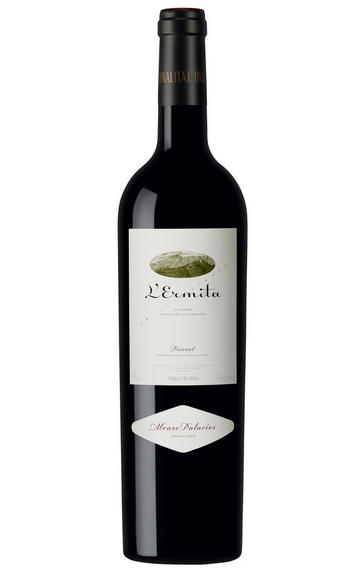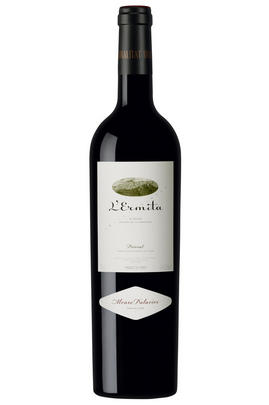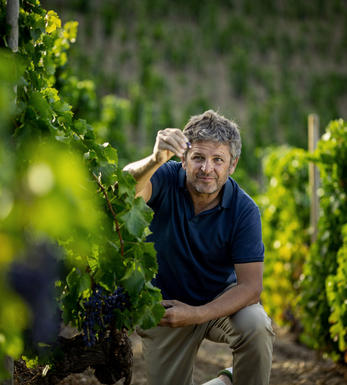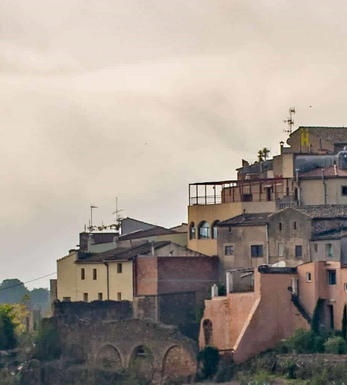
2019 L'Ermita, Álvaro Palacios, Priorat, Spain

Critics reviews
L'Ermita carries the "gran vinya classificada," the top of the official vineyard classification in Priorat, and the 2019 L'Ermita comes from 1.45 hectares planted in 1939 with Garnacha, Cariñena and white grapes. The grapes for the 2019 vintage—73% Garnacha, 26% Cariñena and 1% white grapes (Garnacha Blanca, Macabeo and Pedro Ximenez)—were picked between October 11th and 14th.
The wine is close to 15% alcohol but has a low pH (freshness) from fermenting with 30% whole bunches in oak vats with indigenous yeasts and maturing in French oak casks for 14 months. Contrary to what I saw in many 2019s, this is higher in Cariñena than ever, but the grapes were all co-fermented in two 1,000-liter oak vats, and there is perfect integration of the varieties.
There was an incredible richness of aromas here, perfumed, intoxicating and showy, an extroverted vintage, with a deeper voice than the 2018. There is incredible precision and finesse here, subtleness and elegance. The wine is compact, seamless and with incredible balance. It's both powerful and elegant, and there is energy and light, symmetry and clout.
There are layers and layers here, with a spherical core, fresh and agile, all the things a great wine should have. It has an endless finish. Amazing!
2,070 bottles were filled in May 2021.
Drink 2022 - 2032
Luis Gutiérrez, Wine Advocate (July 2021)
Very subtle and complex aromas of blackberries, crushed stones, flint and cloves with some granite. Full-bodied, yet so tight and beautiful, with ultra-fine tannins that are stealth-like and flow across the palate. There is such elegance and grace in this wine. It builds at the finish.
Drink in 2024, but it's already a joy to taste.
James Suckling, JamesSuckling.com (February 2022)
Nervy dark fruits, notes of cherry with a hint of ripe boysenberry, dried orange peel, light sage, potpourri floral notes, light green peppercorn, with red liquorice and allspice. Brilliant and open on the palate, excellent fruit definition already showing with luscious layers of dark fruits and a lingering threaded acidity with an even longer finish.
Drink 2022 - 2030
Miquel Hudin, Decanter.com (June 2021)
About this WINE

Alvaro Palacios
Alvaro Palacios, whose family owns the prestigious Rioja Bodega, Palacios Remondo, spent two years at Château Pétrus before setting up on his own in Priorat in 1989. From the outset, he set out to produce world-class wines using fruit from extremely low-yielding old vines and applying ultra-modern winemaking techniques.
The cream of the crop is the single vineyard wine L'Ermita, which was first produced in 1993. It is a blend of 80% Garnacha, 15% Cabernet Sauvignon and 5% Cariñena, all aged in new French barriques for up to 20 months. It is bottled unfiltered. It has intense concentration, enormous depth and a complexity which is simply staggering.

Priorat
Priorato, or Priorat, is one of the stand-out Spanish wine regions, with an extraordinary leap in wine quality, reputation and price over the 1990s. This small wine appellation, with 1,700 hectares of vines and just over 60 bodegas, lies to the west of the province of Tarragona in Catalonia.
It includes the municipalities of Scala Dei, Gratallops and Falset, where vines grow on steep terraces at varying altitudes of 100 to 700 metres. The climate is continental, and the region blessed with an exceptional schistous terroir (mostly llicorella with layers of slate and quartz). This schist is part of the same stratum found in the finest vineyards of the Douro, Toro and Ribera del Duero. It provides ideal conditions for growing vines and also contributes to the much-lauded mineral-rich character of Priorato’s wines.
The region’s wines were revolutionised through the efforts of René Barbier. In 1989 he joined forces with a group of eight other winemakers to produce wine from eight plots (or clos), planting the best grapes using modern methods, and harvesting at extremely low yields. This original group included such distinguished bodegas as Alvaro Palacios (Finca Dofi), Costers del Siurana and Mas Martinet.
The group later split up, but the legacy and the international acclaim their wines generated has attracted significant interest and investment in the Priorato region. It is now recognised as one of the great fine wine regions in Spain, rivalling Rioja and Ribera del Duero. The Priorat wines are typically powerful and full-bodied, with a warm, ripe fruitiness and impressive levels of concentration and minerality. The wines are made in all categories from Joven to Gran Reserva, undergoing the same oak ageing as Rioja.
The efforts of the Barbier group proved that old-vine, low-yielding Cariñena and Garnacha is the most planted variety here, followed by Garnacha. Both provide the backbone of the region’s wines, augmented by international varieties such as Merlot, Cabernet Sauvignon and Syrah.
White varieties (i.e. Chenin Blanc, Macabeo, Garnacha Blanca, Viognier and Pedro Ximénez) occupy less than five percent of the vineyard area.
Recommended Producers:
Combier Fischer Gerin (Trio Infernal), Clos Figueres, Alvaro Palacios (Finca Dofi)

Grenache/Garnacha
Grenache (Noir) is widely grown and comes in a variety of styles. Believed to originate in Spain, it was, in the late 20th century, the most widely planted black grape variety in the world. Today it hovers around seventh in the pecking order. It tends to produce very fruity, rich wines that can range quite widely in their level of tannin.
In many regions – most famously the Southern Rhône, where it complements Syrah and Mourvèdre, among other grapes – it adds backbone and colour to blends, but some of the most notable Châteauneuf du Pape producers (such as Château Rayas) make 100 percent Grenache wines. The grape is a component in many wines of the Languedoc (where you’ll also find its lighter-coloured forms, Grenache Gris and Blanc) and is responsible for much southern French rosé – taking the lead in most Provence styles.
Found all over Spain as Garnacha Tinta (spelt Garnaxa in Catalonia), the grape variety is increasingly detailed on wine labels there. Along with Tempranillo, it forms the majority of the blend for Rioja’s reds and has been adopted widely in Navarra, where it produces lighter styles of red and rosado (rosé). It can also be found operating under a pseudonym, Cannonau, in Sardinia.
Beyond Europe, Grenache is widely planted in California and Australia, largely thanks to its ability to operate in high temperatures and without much water. Particularly in the Barossa Valley, there are some extraordinary dry-farmed bush vines, some of which are centuries old and produce wines of startling intensity.


Buying options
Add to wishlist
Description
L'Ermita carries the "gran vinya classificada," the top of the official vineyard classification in Priorat, and the 2019 L'Ermita comes from 1.45 hectares planted in 1939 with Garnacha, Cariñena and white grapes. The grapes for the 2019 vintage—73% Garnacha, 26% Cariñena and 1% white grapes (Garnacha Blanca, Macabeo and Pedro Ximenez)—were picked between October 11th and 14th.
The wine is close to 15% alcohol but has a low pH (freshness) from fermenting with 30% whole bunches in oak vats with indigenous yeasts and maturing in French oak casks for 14 months. Contrary to what I saw in many 2019s, this is higher in Cariñena than ever, but the grapes were all co-fermented in two 1,000-liter oak vats, and there is perfect integration of the varieties.
There was an incredible richness of aromas here, perfumed, intoxicating and showy, an extroverted vintage, with a deeper voice than the 2018. There is incredible precision and finesse here, subtleness and elegance. The wine is compact, seamless and with incredible balance. It's both powerful and elegant, and there is energy and light, symmetry and clout.
There are layers and layers here, with a spherical core, fresh and agile, all the things a great wine should have. It has an endless finish. Amazing!
2,070 bottles were filled in May 2021.
Drink 2022 - 2032
Luis Gutiérrez, Wine Advocate (July 2021)
wine at a glance
Delivery and quality guarantee